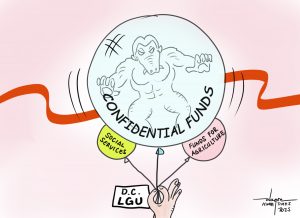 INDEED this multi-billion pesos development project, the Davao mainland-Samal island bridge, will be resulting to a number of people and businesses suffering as a consequence. Buy that is it.
INDEED this multi-billion pesos development project, the Davao mainland-Samal island bridge, will be resulting to a number of people and businesses suffering as a consequence. Buy that is it.
Real development is measured when there are more beneficiaries than sufferers.
In other words, the bridge project. While expected to put IGaCoS to a new economic height, it could also be a “road to perdition” to some people, and even spawn enmity to some of them.
This could also put to a test the ability of the island city’s leaders to find ways to mitigate the suffering of their constituents as the project comes its way.
First we’ll talk of the negative consequences on the people. Early this week we heard Samal mayor Al David Uy on television saying that the local officials are recommending that in order to hasten the start of the project the national government must expropriate the properties that are identified as bars to the project.
Immediately we have in mind the Paradise Island Resort area of the Rodriguez family. And perhaps those adjoining it. And since expropriation is government action the likelihood is that it will succeed even if the aggrieved parties are to fight it out in court.
So, as a result of the expropriation, the resort will be closed and all the people working with it will be given their walking papers. And those small or even ambulant enterprises dependent on the operation of the resort will be displaced as well. And there are a number of them.
For the time being, let us just set aside the environment. That is too debatable an issue that can go on for an endless discussion.
The issue of the loss of jobs to many people is one that affects the stomach. Hence, it is one emotional issue that needs to be addressed while the development is in the process of being introduced.
But let us not limit ourselves to the resort business. Let us also look at the operation of the ferry service between Davao City and Samal. It is the one providing means to connect the island to the mainland without the travelers getting off from any land transportation up to their or the city visitors’ points of destination.
The ferry business though is better situated than the Samal Paradise resort because it is assured of continuity until the bridge is completed and declared passable.
But just the same, the people depending for their livelihood on the ferry’s operation are like convicts waiting for their sentence to be carried out. That is, they’ll be out of jobs or businesses after three years or so, the timetable of the bridge project. Such a wait is excruciating.
But the ferries business is not a totally lost cause. When the bridge is completed it could find new routes that may be able to bring in development to other areas of the island city.
Yes, we heard mayor Uy on the same television interview that the city is now looking at having the ferries service either direct from the Davao City to Talicud Island, or possibly from Kaputian to Talicud, or from Davao de Oro in Pantukan direct to Samal and vice versa.
This last proposed route of the ferry service, to us, is perhaps worth the bite of the ferry operators. This will not only cut the length of travel time for Davao de Oro people and nearby Davao Oriental who want to visit Samal, it would also cut the cost of travel.
So, wherever will be the ferries landing sites in Samal and Pantukan by then, will likely be the beneficiaries of new economic opportunities.
However, should the plan of shifting ferry service from Davao City to Talikud island be realized, the current boat service from Sta. Ana pier in Davao City to Sta. Fe in Talikud will also be adversely affected.
And even if the route will be from Kaputian to Talikud, still the small pump boat service will find its business shun by the passengers. But definitely, this possibility will open new economic opportunities for that long forsaken island in IGaCoS. Talikud, as many who have gone there observed, has a huge potential for development as well.
Only that for now, it’s being isolated by bodies of water from potential investors.
For now, it is our take that government planners and the various stakeholders in the island city and the Davao mainland as well, have to put to the test the real measure of development when the discussion of the pursuance of the bridge project is laid on the table.
If the benefits and the number of beneficiaries far tilt the balance to its favor then perhaps, the potential sufferers must have to accept their fate. Though sad it may be, but that is the reality.
But as it is said in Ecclesiastes, “There is a time for everything,” So, some may lose something with the onset of the bridge project but there is still the possibility that at the end of the road (or call it a bridge) to perdition is the beginning of another road towards full salvation, economically that is.
Of course, the government, both national and local must provide the necessary interventions in cushioning the initial negative impact of the bridge project. The sufferers of that multi-billion development must be seen through by the government while they are still grappling in the dark to survive their fate.


